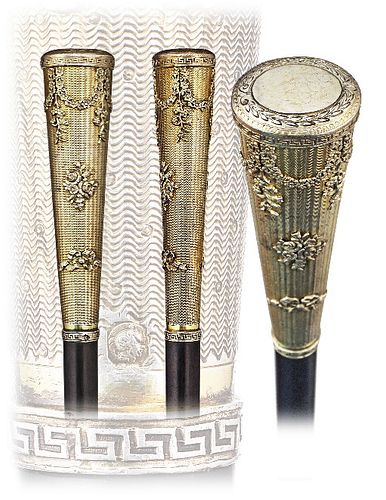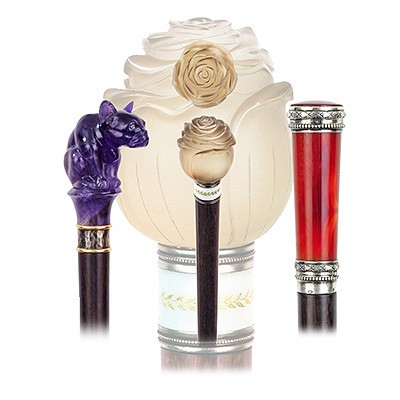Silver Gilt Dress Cane
Lot 35
About Seller
Kimball Sterling
125 West Market Street
Johnson City, TN 37604
United States
Family-owned and family-run Johnson City Tennessee auction business for 25 years. Selling antiques and collectables for 38 years. Kimball M. Sterling, Inc. was founded and is owned by Kimball and Victoria Sterling, time and again, they have laid solid claim to world-wide attention and renown with an...Read more
Categories
Estimate:
$700 - $900
Absentee vs Live bid
Two ways to bid:
- Leave a max absentee bid and the platform will bid on your behalf up to your maximum bid during the live auction.
- Bid live during the auction and your bids will be submitted real-time to the auctioneer.
Bid Increments
| Price | Bid Increment |
|---|---|
| $0 | $10 |
| $100 | $25 |
| $500 | $50 |
| $1,000 | $100 |
About Auction
By Kimball Sterling
Dec 3, 2022
Set Reminder
2022-12-03 13:00:00
2022-12-03 13:00:00
America/New_York
Bidsquare
Bidsquare : The 2022 Cane Masterpiece Auction
https://www.bidsquare.com/auctions/kimball-sterling/the-2022-cane-masterpiece-auction-11295
The European Masterpiece Cane Collection Kimball Sterling kimballsterling@earthlink.net
The European Masterpiece Cane Collection Kimball Sterling kimballsterling@earthlink.net
- Lot Description
-Ca. 1890 -Long and tapering vermeil cane handle delicately engine turned over its entire surface with a repeating brocade-like pattern and dots, embellished at the top with an engraved laurel leave framing band and on the body with applied flower garlands, flower arrangements and knotted ribbons. The handle, which starts oval at the top to end round at the bottom, is framed at both ends with identical meander bands and struck with the French, state guarantee, Minerve hallmark for silver as well as unidentified makers mark with an “A” and “S” and, what seems to be a canine. Dark, almost black and flamed tropical wood shaft and a matching horn ferrule. -Nothing fails to please in this tasteful mascot cane, which sports several features unique to Cazal, the reputed cane and parasol maker from Paris. In any case, it is a celebration of French skills and aesthetics and distinguishes with the timeless charm every collector’s soul love. -H. 4 ¼” x 1”, O.L. 39” -$700-$900 -After a transitional period of economic impoverishment following the Napoleonic wars of the beginning 19th century, Europe and particularly France quickly regained prosperity. With the growing bourgeoisie and a never before seen social revival, the demand for gallantry items, including canes and parasols, must have been enormous as the major capitals saw the appearance of fabulous retailers with Cazal as a leader in Paris. Well known for his elegant accessories and one-of-a-kind canes and umbrellas M. Cazal was indeed a famous French manufacturer who exhibited at the Great Exhibition and created parasols for Empress Eugenie. He patented a spring for parasols in France 1839, which are found in most Cazal parasols. Cazal also wrote a book titled Umbrellas, Parasols and Walkingsticks in 1844, -Vermeil (pronounced vehr-MAY), also known as silver gilt, is a combination of sterling silver, gold, and other precious metals. It is commonly used as a component in jewelry. A typical example is sterling silver coated with 14-karat gold. To be considered vermeil, the gold must also be at least 10-karat and at least 1,5 micrometers thick. Sterling silver covered with another metal cannot be called vermeil. Vermeil can be produced by either fire-gilding or electrolysis. The original fire-gilding process was developed in France in the mid-1700s; however, France later banned the production of vermeil because over time artisans developed blindness due to mercury involved in the process. Today, vermeil is safely produced by electrolysis. -The White House has a collection of vermeil tableware kept on display (when not in use) in the Vermeil Room.
- Shipping Info
-
Each auction has different shipping terms but the buyer always pays. Shipping will be delayed in this auction due to delay of customs.Canes:After payment has been received we will contact you.
- Buyer's Premium
-



 EUR
EUR CAD
CAD AUD
AUD GBP
GBP MXN
MXN HKD
HKD CNY
CNY MYR
MYR SEK
SEK SGD
SGD CHF
CHF THB
THB



















